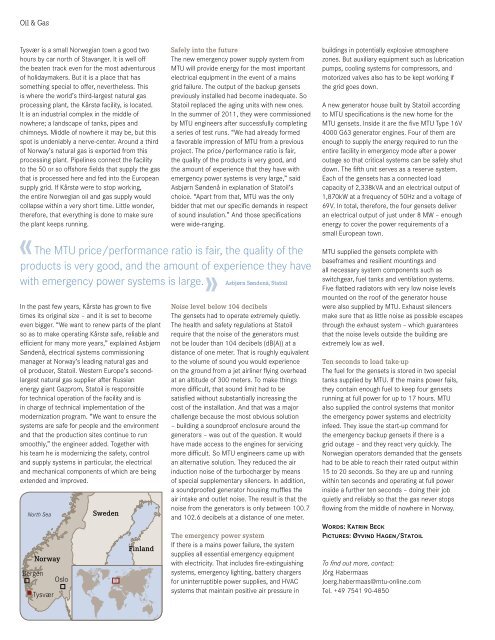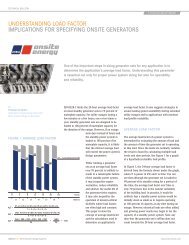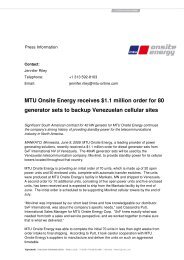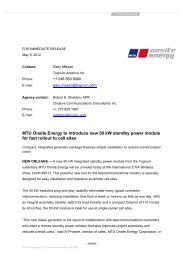Create successful ePaper yourself
Turn your PDF publications into a flip-book with our unique Google optimized e-Paper software.
<strong>MTU</strong> Brown <strong>MTU</strong> Brown<br />
0-17-28-62 80% der Farbe 60%<br />
CMYK CMYK CMYK<br />
<strong>MTU</strong> Blue <strong>MTU</strong> Blue<br />
60%<br />
50-25-0-10 80% der Farbe<br />
CMYK<br />
CMYK CMYK<br />
40%<br />
CMYK<br />
40%<br />
CMYK<br />
20%<br />
CMYK<br />
20%<br />
CMYK<br />
Oil & Gas<br />
Tysvær is a small Norwegian town a good two<br />
hours by car north of Stavanger. It is well off<br />
the beaten track even for the most adventurous<br />
of holidaymakers. But it is a place that has<br />
something special to offer, nevertheless. This<br />
is where the world’s third-largest natural gas<br />
processing plant, the Kårstø facility, is located.<br />
It is an industrial complex in the middle of<br />
nowhere; a landscape of tanks, pipes and<br />
chimneys. Middle of nowhere it may be, but this<br />
spot is undeniably a nerve-center. Around a third<br />
of Norway’s natural gas is exported from this<br />
processing plant. Pipelines connect the facility<br />
to the 50 or so offshore fields that supply the gas<br />
that is processed here and fed into the European<br />
supply grid. If Kårstø were to stop working,<br />
the entire Norwegian oil and gas supply would<br />
collapse within a very short time. Little wonder,<br />
therefore, that everything is done to make sure<br />
the plant keeps running.<br />
In the past few years, Kårstø has grown to five<br />
times its original size – and it is set to become<br />
even bigger. “We want to renew parts of the plant<br />
so as to make operating Kårstø safe, reliable and<br />
efficient for many more years,” explained Asbjørn<br />
Søndenå, electrical systems commissioning<br />
manager at Norway’s leading natural gas and<br />
oil producer, Statoil. Western Europe’s secondlargest<br />
natural gas supplier after Russian<br />
energy giant Gazprom, Statoil is responsible<br />
for technical operation of the facility and is<br />
in charge of technical implementation of the<br />
modernization program. “We want to ensure the<br />
systems are safe for people and the environment<br />
and that the production sites continue to run<br />
smoothly,” the engineer added. Together with<br />
his team he is modernizing the safety, control<br />
and supply systems in particular, the electrical<br />
and mechanical components of which are being<br />
extended and improved.<br />
Safely into the future<br />
The new emergency power supply system from<br />
<strong>MTU</strong> will provide energy for the most important<br />
electrical equipment in the event of a mains<br />
grid failure. The output of the backup gensets<br />
previously installed had become inadequate. So<br />
Statoil replaced the aging units with new ones.<br />
In the summer of 2011, they were commissioned<br />
by <strong>MTU</strong> engineers after successfully completing<br />
a series of test runs. “We had already formed<br />
a favorable impression of <strong>MTU</strong> from a previous<br />
project. The price/performance ratio is fair,<br />
the quality of the products is very good, and<br />
the amount of experience that they have with<br />
emergency power systems is very large,” said<br />
Asbjørn Søndenå in explanation of Statoil’s<br />
choice. “Apart from that, <strong>MTU</strong> was the only<br />
bidder that met our specific demands in respect<br />
of sound insulation.” And those specifications<br />
were wide-ranging.<br />
«The <strong>MTU</strong> price/performance ratio is fair, the quality of the<br />
products is very good, and the amount of experience they have<br />
with emergency power systems is large. »<br />
Asbjørn Søndenå, Statoil<br />
North Sea<br />
Bergen<br />
Norway<br />
Tysvær<br />
Oslo<br />
Sweden<br />
Italy<br />
Finland<br />
Noise level below 104 decibels<br />
The gensets had to operate extremely quietly.<br />
The health and safety regulations at Statoil<br />
require that the noise of the generators must<br />
not be louder than 104 decibels (dB(A)) at a<br />
distance of one meter. That is roughly equivalent<br />
to the volume of sound you would experience<br />
on the ground from a jet airliner flying overhead<br />
at an altitude of 300 meters. To make things<br />
more difficult, that sound limit had to be<br />
satisfied without substantially increasing the<br />
cost of the installation. And that was a major<br />
challenge because the most obvious solution<br />
– building a soundproof enclosure around the<br />
generators – was out of the question. It would<br />
have made access to the engines for servicing<br />
more difficult. So <strong>MTU</strong> engineers came up with<br />
an alternative solution. They reduced the air<br />
induction noise of the turbocharger by means<br />
of special supplementary silencers. In addition,<br />
a soundproofed generator housing muffles the<br />
air intake and outlet noise. The result is that the<br />
noise from the generators is only between 100.7<br />
and 102.6 decibels at a distance of one meter.<br />
The emergency power system<br />
If there is a mains power failure, the system<br />
supplies all essential emergency equipment<br />
with electricity. That includes fire-extinguishing<br />
systems, emergency lighting, battery chargers<br />
for uninterruptible power supplies, and HVAC<br />
systems that maintain positive air pressure in<br />
buildings in potentially explosive atmosphere<br />
zones. But auxiliary equipment such as lubrication<br />
pumps, cooling systems for compressors, and<br />
motorized valves also has to be kept working if<br />
the grid goes down.<br />
A new generator house built by Statoil according<br />
to <strong>MTU</strong> specifications is the new home for the<br />
<strong>MTU</strong> gensets. Inside it are the five <strong>MTU</strong> Type 16V<br />
4000 G63 generator engines. Four of them are<br />
enough to supply the energy required to run the<br />
entire facility in emergency mode after a power<br />
outage so that critical systems can be safely shut<br />
down. The fifth unit serves as a reserve system.<br />
Each of the gensets has a connected load<br />
capacity of 2,338kVA and an electrical output of<br />
1,870kW at a frequency of 50Hz and a voltage of<br />
69V. In total, therefore, the four gensets deliver<br />
an electrical output of just under 8 MW – enough<br />
energy to cover the power requirements of a<br />
small European town.<br />
<strong>MTU</strong> supplied the gensets complete with<br />
baseframes and resilient mountings and<br />
all necessary system components such as<br />
switchgear, fuel tanks and ventilation systems.<br />
Five flatbed radiators with very low noise levels<br />
mounted on the roof of the generator house<br />
were also supplied by <strong>MTU</strong>. Exhaust silencers<br />
make sure that as little noise as possible escapes<br />
through the exhaust system – which guarantees<br />
that the noise levels outside the building are<br />
extremely low as well.<br />
Ten seconds to load take-up<br />
The fuel for the gensets is stored in two special<br />
tanks supplied by <strong>MTU</strong>. If the mains power fails,<br />
they contain enough fuel to keep four gensets<br />
running at full power for up to 17 hours. <strong>MTU</strong><br />
also supplied the control systems that monitor<br />
the emergency power systems and electricity<br />
infeed. They issue the start-up command for<br />
the emergency backup gensets if there is a<br />
grid outage – and they react very quickly. The<br />
Norwegian operators demanded that the gensets<br />
had to be able to reach their rated output within<br />
15 to 20 seconds. So they are up and running<br />
within ten seconds and operating at full power<br />
inside a further ten seconds – doing their job<br />
quietly and reliably so that the gas never stops<br />
flowing from the middle of nowhere in Norway.<br />
Words: Katrin Beck<br />
Pictures: Øyvind Hagen/Statoil<br />
To find out more, contact:<br />
Jörg Habermaas<br />
Joerg.habermaas@mtu-online.com<br />
Tel. +49 7541 90-4850















![Full power range of diesel generator sets [PDF] - MTU Onsite Energy](https://img.yumpu.com/28297693/1/190x253/full-power-range-of-diesel-generator-sets-pdf-mtu-onsite-energy.jpg?quality=85)
